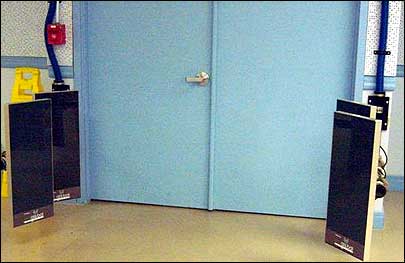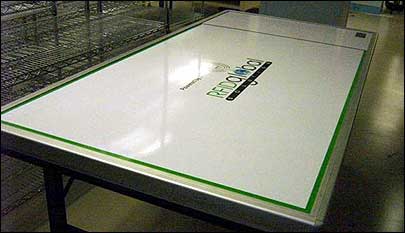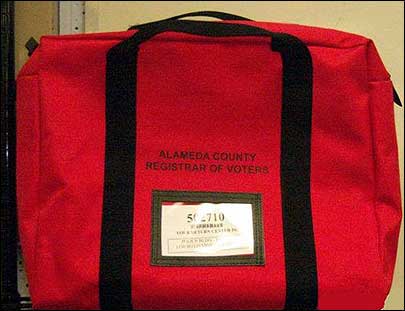Ever since the contentious 2000 U.S. presidential election, the balloting systems employed in many states have come under scrutiny—in part, because the means by which ballots are brought from polling places to a central depository, once polls are closed, has not been a well-officiated process in some states. Alameda County, the seventh largest in California and home to much of the East San Francisco Bay area, including the city of Oakland, is employing RFID to help it ensure that ballots are collected and managed properly. The county debuted the system during a small, local election held on Nov. 6, 2007, and plans to use it during upcoming presidential primaries, scheduled for Feb. 5 in California.
It all started during a casual phone conversation with a business colleague in mid-2006, explains Dave Eagleson, senior VP of sales and marketing for RFID Global Solution, an RFID solutions provider based in Maryland. During that call, Eagleson learned that Alameda County was looking to track ballots, and was encouraged to find out if his company might be able to help. By November of last year, the county’s election board and RFID Global had developed and pilot-tested the system, which was ready for launch.
The number of polling places utilized in Alameda County varies depending on the type of election being held. The Nov. 6 election required only 27 polling places, but the larger turnout for a presidential primary requires the use of all 810 polling places throughout the county. After each polling place closes, county workers place the following items into a canvas bag with a tamper-proof zipper-lock: a memory cartridge containing the voting results scanned from all paper ballots for that location; a PCMCIA card holding the voting results from touch-screen voting machines (used by disabled voters unable to utilize the paper ballots); and a paper list of names for all people who voted at that site.
Previously, each component—the three ballot assets and the canvas bag—carried a bar-coded label with an identifier based on an alphanumeric protocol. Under the RFID system, each also carries a passive RFID tag compliant with the EPC Gen 2 UHF protocol, and in a form factor appropriate to the asset—for instance, the tag attached to the PCMCIA card has an anti-electrostatic backing. The bar codes will continue to be used as a back-up method for identifying the ballot assets and canvas bag.
Prior to Election Day, all four components were RFID-tagged at a central warehouse and distributed to the polling places. The unique IDs encoded to the PCMCIA card, memory cartridge and voter roster were all married to the ID encoded to the canvas bag’s tag.
On Nov. 6, each polling place inserted its PCMCIA card, memory cartridge and roster into its particular bag at the end of the night, explains Dave Macdonald, Alameda County’s director of information technology and registrar of voters. Deputies with the Alameda County Sheriff’s Office then brought the locked bag to a regional collection facility, Macdonald says, which is an intermediary collection point. There are a total of 27 intermediary sites in the county, but the Nov. 6 election required that only five be used. In this case, workers for the Alameda Registrar of Voters used handheld Motorola MC9090-G RFID readers to interrogate the tags inside each bag, as well as the bag tag.
The interrogator communicated, via Wi-Fi, with a central database in RFID Global Solution’s Web-based data-management software, to verify that each bag contained the three asset tags that were supposed to be within it. If any were missing, an alert appeared on the handheld’s monitor so staff could quickly alert workers at the polling location to find that asset. This happened twice during the Nov. 6 election, Macdonald says, and in both cases the missing components were quickly located and brought to the appropriate intermediary collection site. Macdonald watched on his laptop from the county’s central tallying facility as the software indicated the interrogation of the tags at the intermediary sites.

Prior to using RFID, workers opened each bag, manually scanned each asset with a bar-code scanner and then placed it back in the bag, which was relocked. This took additional time and also posed a compromise to the contents’ integrity.
Once each polling station had delivered its bag to the intermediary collection site, all bags were brought from that site to the central tallying facility, where every vote collected throughout the county was counted. While entering the facility, the sheriff’s deputies carried the bags, in groups of up to six, through an RFID reader portal housing a Motorola fixed-position interrogator. As they did so, a staffer watched the monitor of a computer linked to the reader software developed by RFID Global Solution. This generated a simple graphic that showed each bag, by its ID number, along with indicators of whether all three tags within had been read.
The staffer made sure the graphic showed that all assets in each bag were read, and that the number of bags on the graphic matched the amount brought through the portal. If anything was missing, the staffer directed the deputy carrying the bags to a help desk. This kept the portals available for more deputies to continue bringing bags into the facility. “On election night, there is so much going on,” says Macdonald. “If a bag [appears to be] missing something, we don’t want to interrupt the workflow.”
At the help desk, another employee spread the bags out on what RFID Global Solution calls its Smart Table, which contains embedded antennas linked to a fixed-position reader. Because the tags could be placed inside the interrogation zone created by the table for a longer period of time than when they were brought through the portal readers—which are also subject to RF interference from the deputies’ bodies—the table was more likely to read all of the tags present inside each bag, as well as the bag tag itself.
During the Nov. 6 election, any tags missed by the portal reader were successfully interrogated at the Smart Table, so all voting assets used in the election were identified. What’s more, all bags were accounted for within in an hour and 20 minutes of arriving at the central polling facility. This process previously took up to five hours, when the bar codes on each component and bag had to be manually scanned. All of the Nov. 6 votes placed in Alameda County were tallied before 11 pm that evening.

Since the RFID system did not impact the county’s existing means for collecting or counting individual votes, Macdonald says he did not need to seek federal or state approval to implement the RFID-based tracking system. And because it did not change the voting processes offered to voters—either manually, through a machine-read paper ballot, or electronically, through a touch-screen—voters have not protested the system.
“As the director of IT, I love technology, but the front end—the voter experience—that needs to be as low-tech as we can make it,” says Macdonald, adding that while he feels the electronic polling machines work well, the public has a perception that they do not, and he can’t change that opinion. “But on the back end [transporting and accounting for the ballots collected from the polling places], we need to implement technology for automated tracking, efficiency and better workflow.”
Though the number of canvas bags being tracked and collected—and, more importantly, the voting data inside them—will be a thousand times larger during the Feb. 5 presidential primaries than it was for the local Nov. 6 election, Macdonald is confident the RFID system will work just as well. And in the future, he also hopes to begin employing an RFID-based system for tracking the thousands of pieces of voting equipment he must manage—from touch-screen voting machines to paper-ballot scanners.


